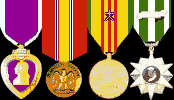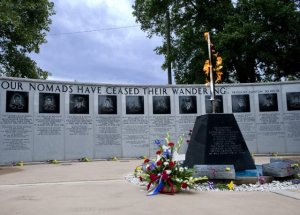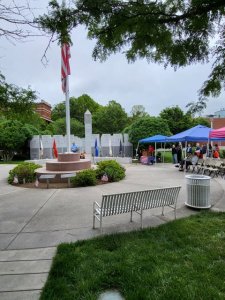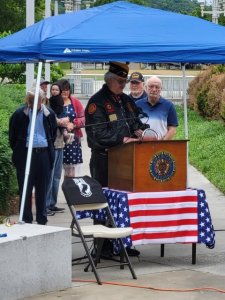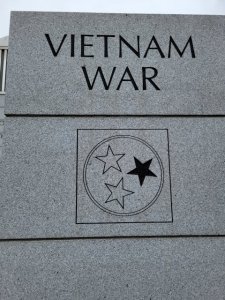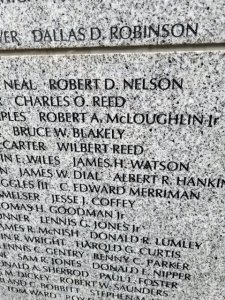OneManGang
Senior Member
- Joined
- Sep 7, 2004
- Messages
- 2,045
- Likes
- 9,730
Three Days in June: The “Cam Hung Sweep” 18-20 June 1968
By Pat Gang
“If you’re “doing” military history, and it doesn’t just break your heart, you’re not doing it right.” – Dr. Charles W. Johnson, University of Tennessee Department of History, 1977
In June 1968, my mother’s family was seared to the core when word reached us that my cousin, Corporal Robert A. McLoughlin, Jr., serving with the United States Marines, had been killed in Vietnam. To this day family members can recall, with blinding clarity, the days afterwards: the first viewing, the funeral and so forth.
One person had always been missing in all this: my cousin. Nobody in the family really knew what Bobby and his fellow Marines were doing that day.
Over Memorial Day weekend in 2007 I found links to his parent unit: the 1st Battalion, 9th Marines (1/9) and its veterans. One of these sites, I found, had all of the Command Chronologies, a number photos, and the topographic maps for all of Quang Tri Province.
This lead to an even greater realization:
I’d found Bobby.
Bobby was a Corporal in the 106mm recoilless rifle platoon, a part of the Headquarters and Service Company of 1/9. H&S was where everybody not connected with one of the rifle companies (Alpha, Bravo, Charlie or Delta) wound up. H&S oversaw the radio operators, mortars, anti-tank platoon and so forth. His normal station was at the North end of a small foot bridge over the Cam Lo River.
What follows is that story.
June, 1968 had started out for the men of 1/9 as a continuation of operations begun in May. 1/9 however, was consolidating. Its component companies began to gather from various outposts and missions and settled into Camp Carroll.
Camp Carroll was a fairly large base resting about a mile south of the Cam Lo River and Route 9 which ran along the river’s southern bank. 1/9’s primary mission was to keep the enemy from using Route 9 as an avenue to attack the provincial capital. As a part of that, 1/9 also guarded the western approached to Dong Ha, a small town northwest of Quang Tri City which boasted a major highway bridge that carried Route 1 over the Cam Lo River. There were other American bases at Dong Ha, where Route 9 and Route 1 intersected.
A few miles upstream from Dong Ha sat the small wooden bridge which carried Route 361 over the Cam Lo River at (appropriately) Cam Lo Village.
June also brought a change of command in the 3rd Marine Division. The new division commander decided the Marines had spent enough time waiting on Charlie, and it was high time to conduct offensive operations and go find him.
Lt. Colonel Mike Palatas , 1/9’s Commanding Officer, formulated his plan. Divisional and Corps intelligence had picked up signs of enemy activity north of the Cam Lo River around the village of Cam Hung. Cam Hung village was about four kilometers (roughly 2½ miles) from the river. It sits in a small valley along a nameless stream that flows south. One enemy unit, the 1st Company of the 27th Independent Battalion, was known to be operating in the vicinity and full regiment (thought to be the 271st) was believed nearby. Also there were assorted artillery and other support units in the area. The isolated company near Cam Hung seemed to make a logical target for the firepower of a full Marine battalion.
The scattered companies of 1st Battalion now made their way to Camp Carroll and began to prepare for the upcoming operation. 1/9 would board CH-46 helicopters at dawn on 18 June for the flight to three Landing Zones (LZ) situated north and northeast of the village. After landing, two companies (Alpha and Delta) on the western LZ (code named “Wren”), would move southeast to a ridge about 500 meters SE of Cam Hung. Bravo Company would have the easternmost LZ (“Owl”) and would then move southwest to Objective “E,” a secondary high point on the same ridge as Alpha and Delta. Charlie Company and H&S would land in the center at LZ “Gull” and then Charlie Company would proceed to Objective “M” located East of Bravo while H&S would link up with Lt. Col. Palatas and set up a battalion CP more or less in the center of 1/9’s positions. Once the objectives were secure the companies would set up NDP’s (Night Defensive Positions) meaning they would set up in a roughly circular position providing 360º security. For this operation the only members of H&S Co. left in the rear with the gear were the mortarmen as the projected AO (area of Operation) was well within the range of their 81mm tubes.
The next morning, the companies would move out and head southeast to the river then dig in again. On the third day, the battalion would cross the river, board trucks, and ride back to Camp Carroll.
Reveille came early for the men of 1/9 on the 18th. By 6:00 AM (0600) they had been briefed and had been assigned to their helo teams and moved to the Camp Carroll LZ to await the CH-46s. The helicopters landed and the Marines boarded. The first lift took off at 7:30. Lance Corporal James Heard of Philadelphia posted a letter to his wife before heading to the LZ.
As the birds took off, artillery from Camp Carroll began pounding the three LZs and planes from Da Nang laid smoke screens around them. The idea was to keep Chuck’s head down and also the smoke would keep him from seeing what was going on. Another unit had recently tried to go in “unannounced” and had suffered terrible casualties when they landed virtually on top of an enemy unit.
1/9 Operations 18 June “The Cam Hung Sweep”
About halfway through the landings, Charlie sprung his own little surprise. Communist 82mm mortars opened up from at least three different positions.
Above the din of rotor blades and shouted orders came a scream: the word nobody wanted to hear.
“INNNNNCOMMMMMINGGGGGG!!!!!”
BOOM! BOOM! BOOM!
“I’m hit!”
BOOM! BOOM!
“Corpsman! Corpsman!”
BOOM! BOOM! BOOM!
“First Squad! To me! … Second Squad! Over there!”
The Marines on LZs WREN, GULL and OWL found themselves in that most hated of events in Vietnam, a “hot LZ.” The basic problem was there was no place to hide. The troops were at their most vulnerable as they jumped off the helicopters and before they could re-form their squads and platoons and move out or dig in. On this day, the enemy was ticked off and accurate. Marines were wounded and killed all over the place. At least ten Marines of 1/9 never made it off the LZs. Charlie Company was especially hard hit. Although the official record is silent, normal military accounting posits 2-3 wounded for every man killed. 1/9 was stuck until the dead and the 25 or so wounded could be MEDEVAC-ed. The pounding went on for a couple of hours.
At about 11:50, Alpha and Delta were able to move about 200 meters or so off their LZ but then came under enemy rifle fire. The resulting firefight lasted about 45 minutes, but no further casualties were taken.
After about three hours of this, with artillery from Camp Carroll and 1/9s own mortars replying to the enemy, Marine fighter bombers appeared overhead. They screamed in on the mortar positions detected by 1/9 and dropped their loads resulting in the confirmed destruction of six bunkers. The incoming fire slacked off and the evacuation helicopters landed and took on their grim cargoes. The last MEDEVAC flight departed at 1315 (1:15 PM.)
One of the Marines who didn't make it off that LZ was LCpl James Heard of Philadelphia.
Finally, 1/9 began to move toward its objectives. The enemy was still full of fight, though. Mortar and rifle fire dogged the Marines the whole day. Late that afternoon, the Marines stormed a pair of bunker complexes near their day’s objectives. By 3:45 Bravo had reached its objective and established an NDP. By 1745 (5:45pm) all units were on the ridge and digging in for the night. The battalion Command Post (CP) was established with Delta Company. Re-supply helicopters arrived bearing food, water and ammo and landed near each company. 1/9 settled in for the night.
At 2322 (11:22 PM) or midnight (see below) mortar shells began raining on Delta Company and the battalion CP. The enemy had lost none of his accuracy and once again the shouts of “Corpsman!” could be heard around the perimeter. Two more Marines were killed in this barrage and 19 more were wounded. One of those last two was my cousin. In all, twelve Marines of 1/9 had lost their lives during the day.
During my research on these events I came into contact with Bert Mullins of who now lives in Texas. On 18 June 1968, though, Bert was a radio operator with 1/9 and he adds this description of the night’s events.
Evening 18 June 1968 (Bert Mullins)
I was a radio operator with H&S 1/9 on the night of June 18, 1968. The call sign for 1/9 was ‘Garden Valley’. I worked the battalion’s radios and so had something of ‘grandstand seat’ for operations.
1/9 set up its Command Group about 4pm in a gully about 30 meters (100’) wide at the base. Delta Company was set up on the perimeter. The sides of the gully were steep – about 45º - and stair- stepped. About 50 meters from the top of the sides were some old NVA bunkers. I bedded down next to one of these old bunkers about 40-50 meters from the Command Post. The idea was that if anything happened we could just roll into the bunker and be relatively safe .The bunker was right on the edge of a relatively level at the lip of the gully area that featured a huge briar patch.
About midnight I woke up. This was unusual. I was also thirsty – that was even more unusual. I got out one of my canteens, took a drink and replaced in the cover. That’s one of the reasons I remember this particular incident. Just as I snapped the second snap, I heard mortar rounds leaving the tube.
The enemy was shooting search and traverse fire. They fired in five-round groups that were “walked” along a particular azimuth (direction) and fell in a line. I dove into the bunker.
After twenty rounds or so the mortars stopped. Probably, they just packed up and left the area. This was not unusual. The NVA knew to the minute how long it would take for our artillery spotters to get an azimuth and call in counter-mortar fire.
Immediately we began to get calls for casualty evacuations. Two radio operators had been wounded and there was one guy killed from Delta Company who was one of the new guys. We did not know immediately that there had been a second KIA. It was about an hour or so before Robert was discovered.
There were at least two MEDEVACs called it. We set up a Landing Zone on the lip of the gully just past the big briar patch. There was much confusion and it took some time to get things sorted out. The fact you couldn’t see your hand in front of your face didn’t help.
I was standing at the LZ when the second helicopter came in; these were the big CH-46s. The 46s had a .50 cal machinegun in the door on each side. I heard the second one coming in but I couldn’t see it and was concerned the thing might land on my head. I figured the best course of action was to stay where I was though. I felt the rotor wash as the CH-46 settled. Then the red interior lights (red lights are used at night so as not to interfere with night vision) came on and I saw the barrel of the left door-gunner’s .50 caliber just over my left shoulder. I gave them hand and arm signals to move forward and they did move about six or eight feet.
1/9’s battle went on.
1/9 departed on the next leg of the operation 0930 on the 19th.
The plan for the 19th of June was for the companies to move out and keep their current alignment: Charlie on the West, then moving east in order, Bravo, Delta, and Alpha. the companies would proceed southeast with Charlie, Bravo and Alpha ending up at Objective “F,” a low ridge on the North Bank of the Cam Lo known as Hill 52. Delta and the battalion Command Group would cross the river and set up an NDP on the south bank.
This movement was executed as planned. During the movement to the river another four Marines were killed, several more were wounded and a number were airlifted out for heat related problems.
On the morning of 20 June, the rest of the battalion crossed the Cam Lo River and moved to a point on Route 9 where they boarded trucks and rode back to Camp Carroll. All units were in camp by 1:00PM. There was one last casualty: a PFC named Michael Rindone was hit by mortar fragments near Route 9. The Command Chronology exerpt attached to his memorial page suggests he was wounded when a fellow Marine triggered a mortar shell used as a land mine – Vietnam’s version of the infamous IED of a more recent unpleasantness. PFC Rindone was MEDEVAC-ed to a hospital ship but died shortly thereafter.
The Cam Hung Sweep was over.
There would be no rest for the weary as there was another “sweep and clear” operation planned for 1/9 and scheduled to jump off the next day. Bravo Company moved out 2330 (11:30PM) on 20 June to secure the LZ for the next morning’s helo-lift.
The next operation would prove as quiet as the Cam Hung operation was violent and bloody. In fact 1/9 would suffer no more combat fatalities during the rest of June. According to the 1/9 Command Chronology, there were 18 men listed as killed in action for June, however, the 1/9 Honor Roll lists nineteen names for June of 1968.

The 18 men of 1/9 who died during the Cam Hung sweep were:
Alpha Company:
Pfc Patrick A. Connelly, Green Bay, WI
Pfc John R. Dowling, Akron, IA
Pfc Michael G. Rindone, Council Bluffs, IA
Bravo Company:
SSgt Robert B. Buchanan, Baltimore, MD
Cpl Clarence V. Mobley, Winnabow, NC
LCpl Clayton H. Johnson, New Orleans, LA
Charlie Company:
SSgt Earl Thomas, Cleveland, OH
LCpl Calvin Golden, Chicago, IL
LCpl David J. Marsh, New York, NY
LCpl Randy L. Mathias, Bountiful, UT
LCpl Donald E. Whiters, Wichita, KS
Pfc Litael Jordan, Los Angeles, CA
Pvt Bobby R. Lane, Goldsboro, NC
Pvt Anthony R. Love, Gastonia, NC
Delta Company:
LCpl Glenn H. Dusbabek, Waco, TX
H&S Company:
Cpl Robert A. McLoughlin, Knoxville, TN
LCpl James C. Heard, Philadelphia, PA
Pfc Basilio Gomez, San Antonio, TX
“Little crosses stand above the dead. They seldom stand alone. Men see to that.”
- Elton E. Mackin, Suddenly We Didn’t Want to Die
Much of the memorabilia, including his medals, from those days was lost in a fire at Bobby’s mother’s house in 1974. In a simple ceremony at her home in the summer of 2007, I recounted for the family the results of my research. At the end, I presented Bobby’s mother with a set of replacement medals.
______, Command Chronicle 1st Battalion, 9th Marines, June 1968.
______, Command Chronicle 1st Battalion, 9th Marines, May 1968
Gregory, Carlos E. Jr, CPT, US Army (ret.), Interview with Charlie Gang 2005
McLoughlin, Bobby, letters to family April/May/June 1968
Mullins, Bert, Interview with Pat Gang 2007
Shmulinson, Jack; Blaisol, LTC Leonard A.; Smith, Charles R. and Dawson, CPT David A., U.S. Marines in Vietnam: The Deciding Year, 1968. Washington, DC. History and Museums Division, Headquarters, United States Marine Corps, 1997.
Cpl. Robert A. Mcloughlin, Jr. at his post overlooking the Cam Lo River, Vietnam, April, 1967 (Author's collection)

© 2007 Pat Gang
By Pat Gang
“If you’re “doing” military history, and it doesn’t just break your heart, you’re not doing it right.” – Dr. Charles W. Johnson, University of Tennessee Department of History, 1977
In June 1968, my mother’s family was seared to the core when word reached us that my cousin, Corporal Robert A. McLoughlin, Jr., serving with the United States Marines, had been killed in Vietnam. To this day family members can recall, with blinding clarity, the days afterwards: the first viewing, the funeral and so forth.
One person had always been missing in all this: my cousin. Nobody in the family really knew what Bobby and his fellow Marines were doing that day.
Over Memorial Day weekend in 2007 I found links to his parent unit: the 1st Battalion, 9th Marines (1/9) and its veterans. One of these sites, I found, had all of the Command Chronologies, a number photos, and the topographic maps for all of Quang Tri Province.
This lead to an even greater realization:
I’d found Bobby.
Bobby was a Corporal in the 106mm recoilless rifle platoon, a part of the Headquarters and Service Company of 1/9. H&S was where everybody not connected with one of the rifle companies (Alpha, Bravo, Charlie or Delta) wound up. H&S oversaw the radio operators, mortars, anti-tank platoon and so forth. His normal station was at the North end of a small foot bridge over the Cam Lo River.
What follows is that story.
June, 1968 had started out for the men of 1/9 as a continuation of operations begun in May. 1/9 however, was consolidating. Its component companies began to gather from various outposts and missions and settled into Camp Carroll.
Camp Carroll was a fairly large base resting about a mile south of the Cam Lo River and Route 9 which ran along the river’s southern bank. 1/9’s primary mission was to keep the enemy from using Route 9 as an avenue to attack the provincial capital. As a part of that, 1/9 also guarded the western approached to Dong Ha, a small town northwest of Quang Tri City which boasted a major highway bridge that carried Route 1 over the Cam Lo River. There were other American bases at Dong Ha, where Route 9 and Route 1 intersected.
A few miles upstream from Dong Ha sat the small wooden bridge which carried Route 361 over the Cam Lo River at (appropriately) Cam Lo Village.
June also brought a change of command in the 3rd Marine Division. The new division commander decided the Marines had spent enough time waiting on Charlie, and it was high time to conduct offensive operations and go find him.
Lt. Colonel Mike Palatas , 1/9’s Commanding Officer, formulated his plan. Divisional and Corps intelligence had picked up signs of enemy activity north of the Cam Lo River around the village of Cam Hung. Cam Hung village was about four kilometers (roughly 2½ miles) from the river. It sits in a small valley along a nameless stream that flows south. One enemy unit, the 1st Company of the 27th Independent Battalion, was known to be operating in the vicinity and full regiment (thought to be the 271st) was believed nearby. Also there were assorted artillery and other support units in the area. The isolated company near Cam Hung seemed to make a logical target for the firepower of a full Marine battalion.
The scattered companies of 1st Battalion now made their way to Camp Carroll and began to prepare for the upcoming operation. 1/9 would board CH-46 helicopters at dawn on 18 June for the flight to three Landing Zones (LZ) situated north and northeast of the village. After landing, two companies (Alpha and Delta) on the western LZ (code named “Wren”), would move southeast to a ridge about 500 meters SE of Cam Hung. Bravo Company would have the easternmost LZ (“Owl”) and would then move southwest to Objective “E,” a secondary high point on the same ridge as Alpha and Delta. Charlie Company and H&S would land in the center at LZ “Gull” and then Charlie Company would proceed to Objective “M” located East of Bravo while H&S would link up with Lt. Col. Palatas and set up a battalion CP more or less in the center of 1/9’s positions. Once the objectives were secure the companies would set up NDP’s (Night Defensive Positions) meaning they would set up in a roughly circular position providing 360º security. For this operation the only members of H&S Co. left in the rear with the gear were the mortarmen as the projected AO (area of Operation) was well within the range of their 81mm tubes.
The next morning, the companies would move out and head southeast to the river then dig in again. On the third day, the battalion would cross the river, board trucks, and ride back to Camp Carroll.
Reveille came early for the men of 1/9 on the 18th. By 6:00 AM (0600) they had been briefed and had been assigned to their helo teams and moved to the Camp Carroll LZ to await the CH-46s. The helicopters landed and the Marines boarded. The first lift took off at 7:30. Lance Corporal James Heard of Philadelphia posted a letter to his wife before heading to the LZ.
As the birds took off, artillery from Camp Carroll began pounding the three LZs and planes from Da Nang laid smoke screens around them. The idea was to keep Chuck’s head down and also the smoke would keep him from seeing what was going on. Another unit had recently tried to go in “unannounced” and had suffered terrible casualties when they landed virtually on top of an enemy unit.
1/9 Operations 18 June “The Cam Hung Sweep”
About halfway through the landings, Charlie sprung his own little surprise. Communist 82mm mortars opened up from at least three different positions.
Above the din of rotor blades and shouted orders came a scream: the word nobody wanted to hear.
“INNNNNCOMMMMMINGGGGGG!!!!!”
BOOM! BOOM! BOOM!
“I’m hit!”
BOOM! BOOM!
“Corpsman! Corpsman!”
BOOM! BOOM! BOOM!
“First Squad! To me! … Second Squad! Over there!”
The Marines on LZs WREN, GULL and OWL found themselves in that most hated of events in Vietnam, a “hot LZ.” The basic problem was there was no place to hide. The troops were at their most vulnerable as they jumped off the helicopters and before they could re-form their squads and platoons and move out or dig in. On this day, the enemy was ticked off and accurate. Marines were wounded and killed all over the place. At least ten Marines of 1/9 never made it off the LZs. Charlie Company was especially hard hit. Although the official record is silent, normal military accounting posits 2-3 wounded for every man killed. 1/9 was stuck until the dead and the 25 or so wounded could be MEDEVAC-ed. The pounding went on for a couple of hours.
At about 11:50, Alpha and Delta were able to move about 200 meters or so off their LZ but then came under enemy rifle fire. The resulting firefight lasted about 45 minutes, but no further casualties were taken.
After about three hours of this, with artillery from Camp Carroll and 1/9s own mortars replying to the enemy, Marine fighter bombers appeared overhead. They screamed in on the mortar positions detected by 1/9 and dropped their loads resulting in the confirmed destruction of six bunkers. The incoming fire slacked off and the evacuation helicopters landed and took on their grim cargoes. The last MEDEVAC flight departed at 1315 (1:15 PM.)
One of the Marines who didn't make it off that LZ was LCpl James Heard of Philadelphia.
Finally, 1/9 began to move toward its objectives. The enemy was still full of fight, though. Mortar and rifle fire dogged the Marines the whole day. Late that afternoon, the Marines stormed a pair of bunker complexes near their day’s objectives. By 3:45 Bravo had reached its objective and established an NDP. By 1745 (5:45pm) all units were on the ridge and digging in for the night. The battalion Command Post (CP) was established with Delta Company. Re-supply helicopters arrived bearing food, water and ammo and landed near each company. 1/9 settled in for the night.
At 2322 (11:22 PM) or midnight (see below) mortar shells began raining on Delta Company and the battalion CP. The enemy had lost none of his accuracy and once again the shouts of “Corpsman!” could be heard around the perimeter. Two more Marines were killed in this barrage and 19 more were wounded. One of those last two was my cousin. In all, twelve Marines of 1/9 had lost their lives during the day.
During my research on these events I came into contact with Bert Mullins of who now lives in Texas. On 18 June 1968, though, Bert was a radio operator with 1/9 and he adds this description of the night’s events.
Evening 18 June 1968 (Bert Mullins)
I was a radio operator with H&S 1/9 on the night of June 18, 1968. The call sign for 1/9 was ‘Garden Valley’. I worked the battalion’s radios and so had something of ‘grandstand seat’ for operations.
1/9 set up its Command Group about 4pm in a gully about 30 meters (100’) wide at the base. Delta Company was set up on the perimeter. The sides of the gully were steep – about 45º - and stair- stepped. About 50 meters from the top of the sides were some old NVA bunkers. I bedded down next to one of these old bunkers about 40-50 meters from the Command Post. The idea was that if anything happened we could just roll into the bunker and be relatively safe .The bunker was right on the edge of a relatively level at the lip of the gully area that featured a huge briar patch.
About midnight I woke up. This was unusual. I was also thirsty – that was even more unusual. I got out one of my canteens, took a drink and replaced in the cover. That’s one of the reasons I remember this particular incident. Just as I snapped the second snap, I heard mortar rounds leaving the tube.
The enemy was shooting search and traverse fire. They fired in five-round groups that were “walked” along a particular azimuth (direction) and fell in a line. I dove into the bunker.
After twenty rounds or so the mortars stopped. Probably, they just packed up and left the area. This was not unusual. The NVA knew to the minute how long it would take for our artillery spotters to get an azimuth and call in counter-mortar fire.
Immediately we began to get calls for casualty evacuations. Two radio operators had been wounded and there was one guy killed from Delta Company who was one of the new guys. We did not know immediately that there had been a second KIA. It was about an hour or so before Robert was discovered.
There were at least two MEDEVACs called it. We set up a Landing Zone on the lip of the gully just past the big briar patch. There was much confusion and it took some time to get things sorted out. The fact you couldn’t see your hand in front of your face didn’t help.
I was standing at the LZ when the second helicopter came in; these were the big CH-46s. The 46s had a .50 cal machinegun in the door on each side. I heard the second one coming in but I couldn’t see it and was concerned the thing might land on my head. I figured the best course of action was to stay where I was though. I felt the rotor wash as the CH-46 settled. Then the red interior lights (red lights are used at night so as not to interfere with night vision) came on and I saw the barrel of the left door-gunner’s .50 caliber just over my left shoulder. I gave them hand and arm signals to move forward and they did move about six or eight feet.
1/9’s battle went on.
1/9 departed on the next leg of the operation 0930 on the 19th.
The plan for the 19th of June was for the companies to move out and keep their current alignment: Charlie on the West, then moving east in order, Bravo, Delta, and Alpha. the companies would proceed southeast with Charlie, Bravo and Alpha ending up at Objective “F,” a low ridge on the North Bank of the Cam Lo known as Hill 52. Delta and the battalion Command Group would cross the river and set up an NDP on the south bank.
This movement was executed as planned. During the movement to the river another four Marines were killed, several more were wounded and a number were airlifted out for heat related problems.
On the morning of 20 June, the rest of the battalion crossed the Cam Lo River and moved to a point on Route 9 where they boarded trucks and rode back to Camp Carroll. All units were in camp by 1:00PM. There was one last casualty: a PFC named Michael Rindone was hit by mortar fragments near Route 9. The Command Chronology exerpt attached to his memorial page suggests he was wounded when a fellow Marine triggered a mortar shell used as a land mine – Vietnam’s version of the infamous IED of a more recent unpleasantness. PFC Rindone was MEDEVAC-ed to a hospital ship but died shortly thereafter.
The Cam Hung Sweep was over.
There would be no rest for the weary as there was another “sweep and clear” operation planned for 1/9 and scheduled to jump off the next day. Bravo Company moved out 2330 (11:30PM) on 20 June to secure the LZ for the next morning’s helo-lift.
The next operation would prove as quiet as the Cam Hung operation was violent and bloody. In fact 1/9 would suffer no more combat fatalities during the rest of June. According to the 1/9 Command Chronology, there were 18 men listed as killed in action for June, however, the 1/9 Honor Roll lists nineteen names for June of 1968.

The 18 men of 1/9 who died during the Cam Hung sweep were:
Alpha Company:
Pfc Patrick A. Connelly, Green Bay, WI
Pfc John R. Dowling, Akron, IA
Pfc Michael G. Rindone, Council Bluffs, IA
Bravo Company:
SSgt Robert B. Buchanan, Baltimore, MD
Cpl Clarence V. Mobley, Winnabow, NC
LCpl Clayton H. Johnson, New Orleans, LA
Charlie Company:
SSgt Earl Thomas, Cleveland, OH
LCpl Calvin Golden, Chicago, IL
LCpl David J. Marsh, New York, NY
LCpl Randy L. Mathias, Bountiful, UT
LCpl Donald E. Whiters, Wichita, KS
Pfc Litael Jordan, Los Angeles, CA
Pvt Bobby R. Lane, Goldsboro, NC
Pvt Anthony R. Love, Gastonia, NC
Delta Company:
LCpl Glenn H. Dusbabek, Waco, TX
H&S Company:
Cpl Robert A. McLoughlin, Knoxville, TN
LCpl James C. Heard, Philadelphia, PA
Pfc Basilio Gomez, San Antonio, TX
“Little crosses stand above the dead. They seldom stand alone. Men see to that.”
- Elton E. Mackin, Suddenly We Didn’t Want to Die
Much of the memorabilia, including his medals, from those days was lost in a fire at Bobby’s mother’s house in 1974. In a simple ceremony at her home in the summer of 2007, I recounted for the family the results of my research. At the end, I presented Bobby’s mother with a set of replacement medals.
Sources
______, Command Chronicle 1st Battalion, 9th Marines, June 1968.
______, Command Chronicle 1st Battalion, 9th Marines, May 1968
Gregory, Carlos E. Jr, CPT, US Army (ret.), Interview with Charlie Gang 2005
McLoughlin, Bobby, letters to family April/May/June 1968
Mullins, Bert, Interview with Pat Gang 2007
Shmulinson, Jack; Blaisol, LTC Leonard A.; Smith, Charles R. and Dawson, CPT David A., U.S. Marines in Vietnam: The Deciding Year, 1968. Washington, DC. History and Museums Division, Headquarters, United States Marine Corps, 1997.
Cpl. Robert A. Mcloughlin, Jr. at his post overlooking the Cam Lo River, Vietnam, April, 1967 (Author's collection)

© 2007 Pat Gang
Last edited:


